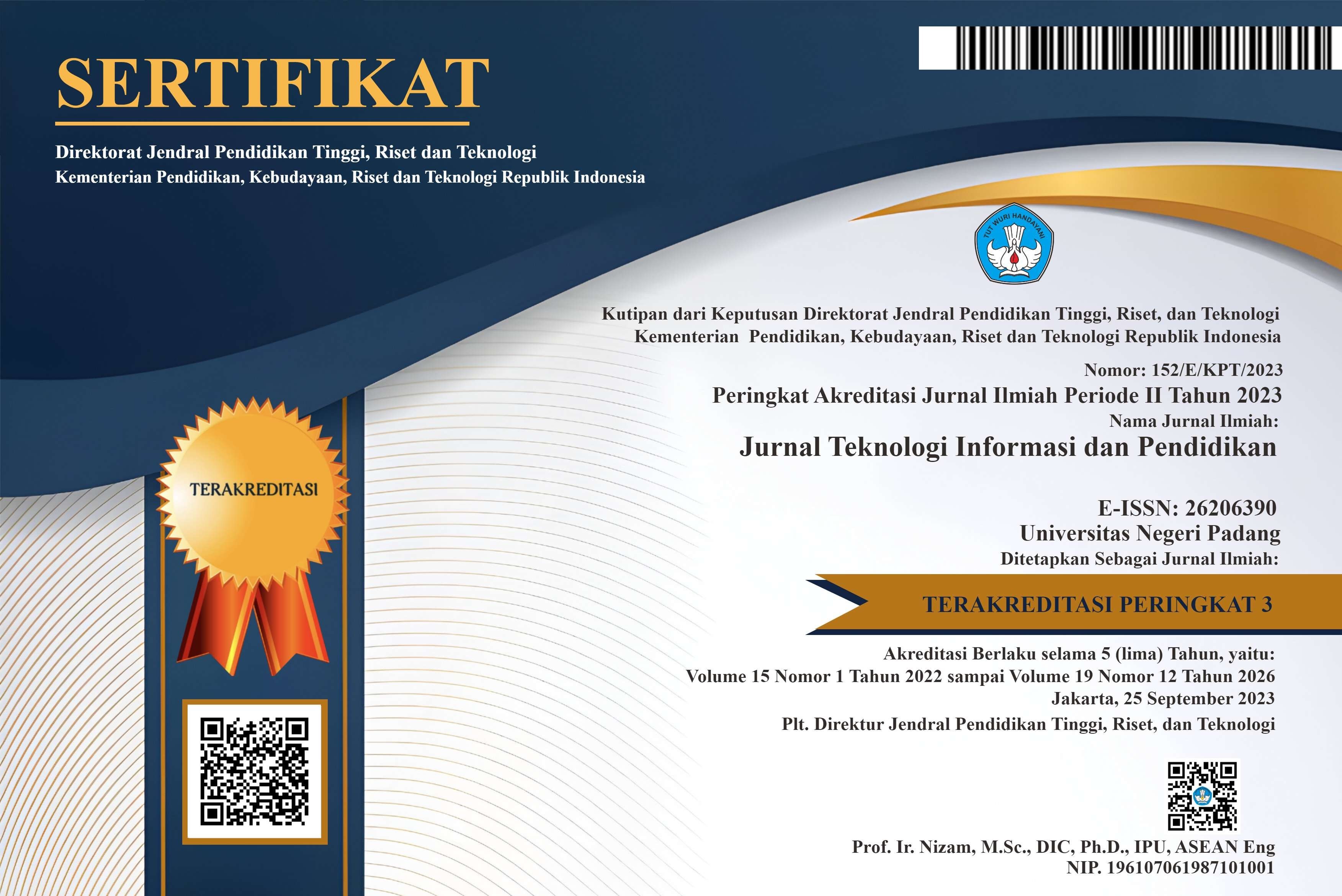Design of Interactive Learning Media for Human Respiratory System Topic
Abstract
The purpose of this research is to assist teachers in averaging the delivery and explanation of the human respiratory system. Besides, it can help improve the quality of student learning and help students to carry out the learning process independently. This study used an Object-Oriented Analysis Design (OOAD) system approach, a system design tool using Unified Modeling Language (UML), and a system development method using the ADDIE method. The results of this research are the design of instructional media in the form of analysis and design (storyboard) interactive multimedia applications containing material about the human respiratory system presented in the form of audio, video, and animation. In addition, the design of this interactive learning media application helps teachers in equating the delivery and explanation of the subject matter, can improve the quality of student learning, help students to carry out the learning process independently. With the design of this interactive learning media application, it can provide an overview to teachers and students about interactive learning media of the human respiratory system that can help the teaching and learning process
References
Rizal, Fahmi, et al, "Comparison of ICT using in learning between Indonesia and Malaysia." Journal of Physics: Conference Series, vol. 1387, no. 1, pp. 1-13, Nov. 2019, doi:10.1088/1742-6596/1387/1/012133.
Lie, Anita, et al, "Secondary school language teachers’ online learning engagement during the COVID-19 pandemic in Indonesia, " Journal of Information Technology Education: Research, vol. 19, pp. 803-832, 2020. doi.org/10.28945/4626
Hamidi, Farideh, et al, "A comparison of the use of educational technology in the developed/developing countries." Procedia Computer Science 3, pp. 374-377, Dec. 2011, doi:10.1016/j.procs.2010.12.063.
Sarker, Md Nazirul Islam, et al, "Leveraging digital technology for better learning and education: a systematic literature review.", Int. J. Inf. Educ. Technol, vol.9, no. 7, pp. 453-461, July. 2019, doi: 10.18178/ijiet.2019.9.7.1246.
Cloete, Anita L, "Technology and education: Challenges and opportunities.", HTS Theological Studies, vol. 73, no. 4, pp. 1-7, Oct. 2017, doi.org/10.4102/hts.v73i3.4589.
Nepo, Kaori, "The use of technology to improve education.", Child & Youth Care Forum, vol. 46, no. 2, pp. 207-221, Apr. 2017 DOI:10.1007/s10566-016-9386-6.
Hanimoglu, Egemen, "The Impact Technology Has Had on High School Education over the Years.", World Journal of Education, vol. 8, no. 6, pp. 95-106, Dec. 2018, doi.org/10.5430/wje.v8n6p96.
Wardani, Dwi Lestari, I. Nyoman Sudana Degeng, and Abd Cholid. "Developing interactive multimedia model 4D for teaching natural science subject." International Journal of Education and Research, vol. 7, no. 1, pp. 63-72, Jan. 2019.
Sahronih, Siti, Agung Purwanto, and M. Syarif Sumantri, "The effect of interactive learning media on students' science learning outcomes.", Proceedings of the 2019 7th International Conference on Information and Education Technology, Mar. 2019, DOI:10.1145/3323771.3323797.
Astuti, Lia, Yaya Wihardi, and Diana Rochintaniawati. "The Development of Web-Based Learning Using Interactive Media for Science Learning on Levers in Human Body Topic." Journal of Science Learning, vol. 3, no. 2, pp. 89-98, Mar. 2020, doi:10.17509/jsl.v3i2.19366.
Zubaidah, S., Mahanal, S., Yuliati, L., Dasna, I. W., Pangestuti, A. A., Puspitasari, D. R., Mahfudhillah, H. T., Robitah, A., Kurniawati, Z. L., Rosyida, F., Sholihah, M., Wulan, A. R., Susilo, H., Padri, IM., Rosana, D., Ratnaningsih, E., Paristiowati, M., Mudzakir, A. and Idah, F. A, Ilmu Pengetahuan Alam Pusat Kurikulum dan Perbukuan Balitbang Kemendikbud, pp 45–76, 2017.
Vlachopoulos, Dimitrios, and Agoritsa Makri, "The effect of games and simulations on higher education: a systematic literature review." International Journal of Educational Technology in Higher Education, vol. 14, no. 1, pp. 1-33, Dec. 2017, doi:10.1186/s41239-017-0062-1.
Sari, Sri Adelila, "The development of mind mapping media in flood material using ADDIE model.”, Journal of Education and Learning (Edu Learn), vol. 10, no. 1, pp. 53-62, Feb. 2016, doi:10.11591/edulearn.v10i1.3227.
Gusmida, Rifqa, and Nur Islami, "The development of learning media for the kinetic theory of gases using the ADDIE model with augmented reality.", Journal of Educational Sciences, vol. 1, no. 1, pp. 1-10, 2017, dx.doi.org/10.31258/jes.1.1.p.1-10.
R P Dhaniawaty, A L Suci, and B Hardiyana, “Aplikasi Pembelajaran Multimedia Interaktif Mata Pelajaran IPA Mengenai Sistem Pencernaan Manusia Untuk Siswa SMP Kelas VII”, JATI, vol. 11, no. 2, pp. 183-194, Oct. 2021, doi.org/10.34010/jati.v11i2.5574.
Y Fadillah, B Hardiyana, and R P Dhaniawaty, “Perancangan Game Edukasi ‘The Legend of Al-Khawarizmi’ sebagai Alat Bantu Pembelajaran Mahasiswa Berkebutuhan Khusus”, jpkk, vol. 5, no. 2, pp. 103–111, Jul. 2021, https://doi.org/10.24036/jpkk.v5i2.583.
Copyright (c) 2022 Jurnal Teknologi Informasi dan Pendidikan

This work is licensed under a Creative Commons Attribution-ShareAlike 4.0 International License.















.png)















